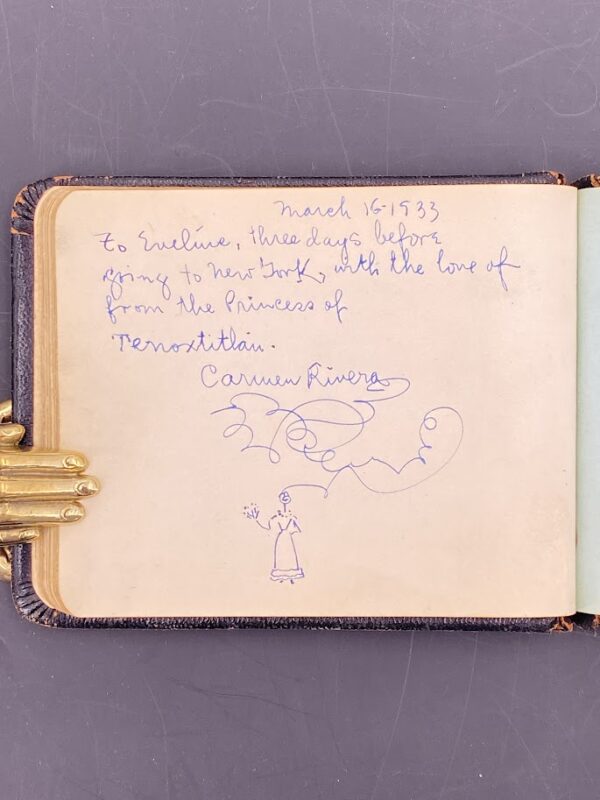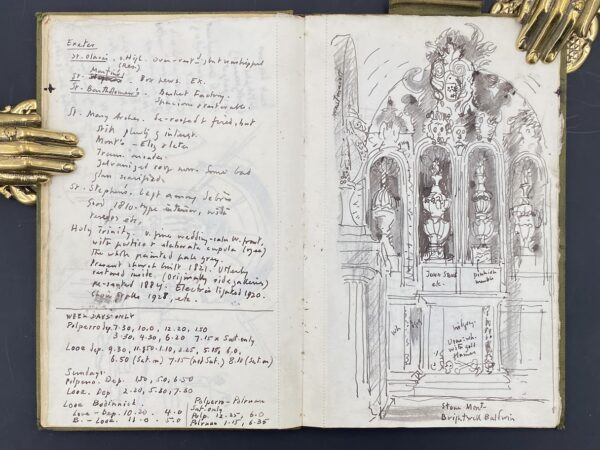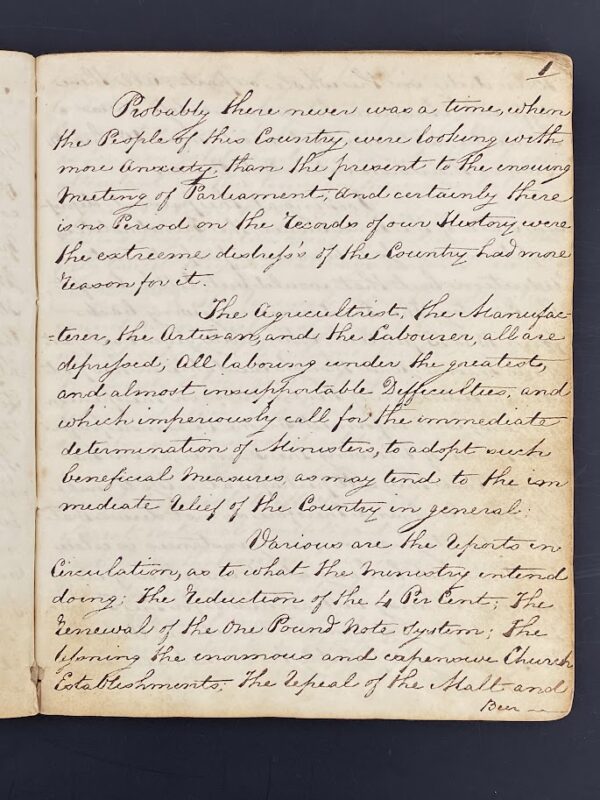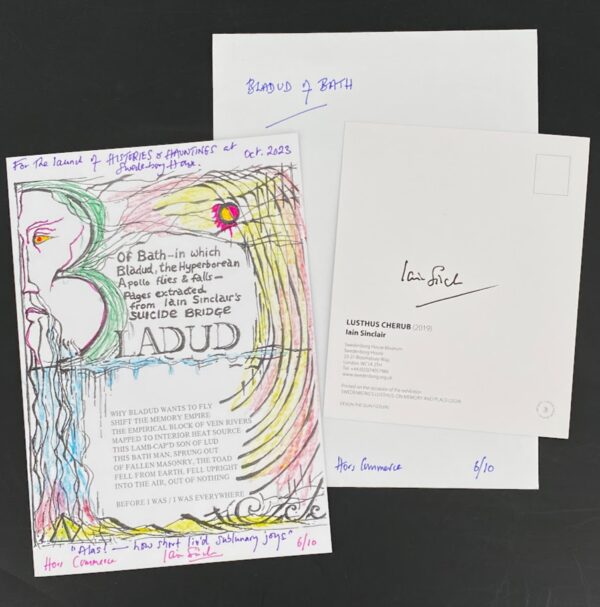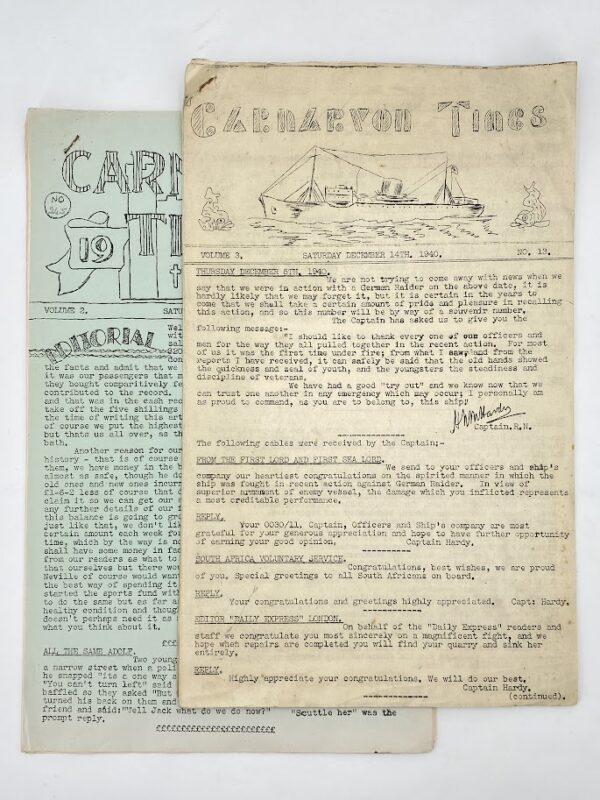
David Gascoyne [Surrealist Poet]
Substantial bound manuscript by the poet David Gascoyne (1916-2001) together with an archive of photographs, letters from Gascoyne and his wife Judy Gascoyne and from Alan Clodd of the Enitharmon Press and many others. This collection which dates from David Gascoyne's later years was acquired by his friend the society photographer Pamela Chandler (1928-1993) who seems to have brokered several sales of Gascoyne's manuscripts and become a friend of both the poet and his wife in the process. The main item here is the bound manuscript which runs to 155 pages in Gascoyne's hand, 1989-1991, written within a blank French 'Livre de Brouillon'. The manuscript is a mixture of draft letters and other writings, mostly in English but with occasional forays in French and including notes for a talk on Elizabeth and Robert Browning. The draft correspondence comprises letters to a variety of personal and literary friends who include the writer George Steiner (about the hostile critical reception of his recently published Real Presences) the comedian and performer Barry Humphries, the novelist Alan Hollinghurst, then Literary Editor of The Independent (about an obituary of his friend Salvador Dali), the campaigning organisation Greenpeace, a musician who'd set his verse to music, Hay on Wye Festival, the Editor of the Independent on Sunday (about Salman Rushdie), Edward Jabes (in French), novelist Tracy Chevalier, and the office of the Prime Minister at 10 Downing Street regarding payment of his Civil List Pension. Additionally there are 16 letters and cards from David Gascoyne to Chandler; a further 50 from Gascoyne's wife Judy Gascoyne to Pamela Chandler and 13 from Alan Clodd at Enitharmon Press to Gascoyne and Pamela Chandler. In his letters Gascoyne offers insights into his creative life as he balances the demands placed on him as a poetic and political survivor from the 1930s and 1940s with the associated requests for memories via interviews, speeches, academic contributions, and readings that became his later life even as he continued to write poetry. David Gascoyne was heavily associated with the Surrealist movement, achieved early success and lived in Paris after the second war before falling into mental ill-health. This collection which dates from his old age, and crucially, comes after his marriage, reveals his intense literary activity and attention to his own legacy - the notebook includes a letter to Reading University in which Gascoyne offered to sell them one of his manuscripts. Judy Gascoyne's voluminous correspondence tracks her husband's movements, often recording others' appreciation of him - and sometimes their understanding - of his poems, especially the great and the good. She suggests that Chandler organise an exhibition of Gascoyne's work and writes interestingly about his wider cultural reception, sending a postcard from an all expenses paid Mediterranean tour courtesy of the Greek government which hosted the ageing poet. The Gascoynes' friend Pamela Chandler (1928-1993) was a leading London based photographer who became the photographer of choice for the publicly evasive J. R. R. Tolkien after being commissioned by his publisher to photograph him in 1961. She has the distinction of being the first female photographer to produce an official portrait of a Prime Minister when she photographed Harold Macmillan. After her death her collection was curated by her sister Diana Willson who also corresponded with Gascoyne's widow, Judy, as witnessed in this collection. Please contact Christian White Rare Books Ltd for more information or images of this item

Frida Kahlo - Carmen Rivera; Diego Rivera
An extraordinary memento of the creative presence of the artistic super-couple Frida Kahlo and Diego Rivera - 'equals and accomplices' as they were described - in the mid-western city of Detroit, early in 1933. With these drawings into a young woman's autograph album, made a few days before their departure for New York, Kahlo and Rivera marked the close of a period of great artistic achievement for them both. Three days before these drawings were created Rivera finished his industrial frescoes and Kahlo ended her anguished sequence of Detroit canvases. In her drawing and inscription Kahlo has overtly recognised this transitional moment. Her miniature figure of a holds out flowers ('I paint flowers so they will not die' - Kahlo) and in her inscription she looks forward to moving to New York. Kahlo emphasises her Mexican identity by calling herself the 'Princess of Tenoxtitlan' (sic) and signing herself 'Carmen Rivera' as she did on her Detroit paintings. To the album Rivera contributes two remarkable drawings: a mask-wearing man who resembles closely his masked automotive engineers on the north wall of what is now Rivera Court at the Detroit Art Institute. In his second figure Rivera depicts a serene, upwards-gazing African-American man viewed in profile with his work mask pushed nto his forehead. Together Kahlo and Rivera spent much of 1932 and early 1933 in Detroit where Rivera had been commissioned to create a series of frescoes for the Detroit Art Institute which would draw upon the city's industrial heritage. It is generally acknowledged that while in the city both artists hit 'a career peak' as Rivera completed his DIA mural and Kahlo worked intensely on a series of portraits dealing with her personal struggles. Rivera remembered how: 'Frieda began work on a series of masterpieces which had no precedent in the history of art. Never before had a woman put such agonized poetry on canvas as Frida did at this time in Detroit.' Whilst they lived in the city the couple were feted and entertained by Detroit's elite. Kahlo in particular responded provocatively to her American hosts: 'the expansive Rivera speaking Spanish and French and demanding all the attention, with the petite and caustic Kahlo dressed in colorful Mexican costumes. At Henry Ford's sister's home, Frida talked on about the wonders of communism. At a dinner at Henry Ford's she asked the anti-semitic industrialist if he was Jewish.' One of the other elite Detroit households who entertained Kahlo and Rivera was the Cohen family, parents of Evelyn Cohen who, on the evening of March 13, 1933, persuaded Kahlo and Rivera to inscribe her little album. This album captures a pivotal moment in art history. PROVENANCE: Evelyn Cohen and by descent. EVELYN COHEN'S ALBUM: Padded black roan (15x11.5cm), maker's stamp of 'Horn Est 1846, [ff] 48, alternating pink, yellow, blue leaves, c 60 entries - the entries do not follow chronological order but range over the years from 1922-1934 including, school teachers, friends, musicians, written in English and sometimes in Hebrew. Kahlo's miniature of a woman with flowers is balanced by her thoughtful inscription written in faulty English: 'March 16. 1933 To Eveline, three days before going to New York, with the love of from [sic] the Princess of Tenoxtitlan Carmen Rivera'. Below this Kahlo has placed her tiny figure of a woman holding a bunch of flowers away from her body and a huge swirling pen line that connects the woman with her signature and inscription above. Using blue ink Rivera has made two drawings: the first depicts a man wearing a gas mask and goggles, very similar to the masked figure he muralled on the automotive north wall of what is now Rivera Court at the Detroit Art Institute and wrote below: 'D.R. To beautiful Eveline'. On the adjacent leaf Rivera has sketched an African-American man in profile, apparently wearing goggles which have been pushed up onto his forehead and inscribed 'Diego Rivera Detroit March 16 1933'.

John Piper
A remarkably rich wartime sketch-book in which John Piper recorded his 1943 summer tour of Devon and Cornwall in the company of Geoffrey Grigson, sketched Welsh landscapes as well as the Victorian villas and churches of the English Midlands while he stayed at Renishaw Hall, home of his friends Edith and Osbert Sitwell. Piper's sketches include churches in Exeter and West Ogwell in Devon, Lackington (later worked-up into an illustration to Betjeman's Guide to English Parish Churches) and Hemington in Leicestershire. From Cornwall Piper has sketched a ruin that would evolve into his 1943 'farmyard chapel' aquatint at Botallack and there are around a dozen sketches and watercolours of Piper's beloved Victorian villas, soon to be the subject of his collaboration with J M Richards in Castles on the Ground. Alongside the sketching, note-taking and train times, Piper also includes reading notes relating to Ruskin's Stones of Venice. Almost all of Piper's archive went to the Tate Gallery making this a rarity on the open market. PHYSICAL DESCRIPTION Green cloth-effect paper over boards (23.5x15.5cm), spattered with paint, with a now-loose elastic closure band and a pencil sleeve. The sketchbook has the label of the London stationer, C Robertson and Co 'Sketch Book Hand Made Water Colour Paper', priced in pencil '5/8' with a pencilled note in Piper's hand opposite relating to his friend the architectural historian Nikolaus Pevsner. The sketch book's pages are of thick wove paper, designed to take water-colour, with a line of perforations 1cm from the gutter, similar to Piper's other notebooks that Piper used for sketching in the field (see Plates 76/77, Piper's Places, 1983). The manuscript comprises 21 leaves, one inserted drawing and one inserted postcard, with a similar number of stubs where pages have been removed - two of which have residue of black wash, similar to extant watercolour landscape sketches that survive in the sketchbook. Very much work in progress, the sketchbook records several facets of Piper's practice in 3 pages of pencil drawings; 7 pages of pen and watercolour wash, 12 pages of ink drawings and 5 pages of notes - 28 pages in total, with 14 blanks - mostly the versos of the more substantial watercolours. PROVENANCE: given by John Piper to Orde Levinson, friend and author of The Prints of John Piper: A Catalogue Raisonne, 1923-1991. NARRATIVE: WEST COUNTRY The first part of the sketch-book records Piper's July 1943 trip to the west country and into Cornwall that he took with Geoffrey Grigson. The sketchbook starts in Devon 'between Torbryan and Denbury' where Piper sketched, annotated and watercoloured a late Georgian house; continuing a mile up the road to the church at West Ogwell which is the subject of an ink sketch with extensive architectural annotation: 'dark box pews pitch pine (mostly removed) Jac.[obean] pulpit.' In Exeter Piper visited 6 of the city churches, particularly enjoying 'Holy Trinity. v fine wedding-cake W. front with portico & elaborate cupola (ogee) the whole painted pale grey.' and opposite these descriptions he made a carefully worked ink sketch of a blank arcade of niches, each with its urn and surmounted by a stone coat of arms. Below his church notes (recto), Piper has jotted down train (or perhaps bus) times from Exeter to Polperro and Looe in Cornwall. Once in Polperro Piper sketched a house on 'Meadow Terrace', adding additional annotation in orange crayon. The first of the sketchbook's watercolours follows this sketch, depicting a shower of rain over a coastal outcrop - perhaps from the south Cornish coastline near Polperro. Piper and Grigson's journey west reached its furthest point with two ink sketches of Hall Place, Botallack. The first of these is an exterior view which is a preparatory sketch for his aquatint completed in the same year (Hall Place, Botallack, Levinson 29), a sketchy rendering with three annotations and on the following leaf an internal view of the same buildi

Luke Batten; Thomas Brand, Lord Dacre.
A singular early nineteenth century letterbook that centres on a polemical essay sent to Thomas Brand, 20th Baron Dacre, on the state of the British nation and the need for multiple reforms, notably parliamentary reform which would be achieved in the Great Reform Act only two years later. To the rear of the volume Dacre's thoughtful reponse to his former Hertfordshire neighbour and perhaps constituent has been tipped in. PHYSICAL DESCRIPTION Quarto format, full fawn limp leather, ruled and roll-tooled in blind, remnants of hand-written white paper title label pasted to front cover; soiled and rubbed, losses to spine, corners worn and rounded. Bands of browning, from glue, to endpapers which are peeling at head and tail of front hinge, small losses, but wrappers remain firmly attached. 46 leaves 92 pages blank paper; numbering begins on first page, running f. 1, pp. 1-4, ff. 5-41; text continuous, except three blank pages between entries, script ends on [p. 80], followed by 7 blank leaves. The author has compiled an index of letters and subjects to the verso of the front endpaper. Script, in brown ink, in an attractive, open and (mostly) legible hand; toned with some foxing, ink smudges and crossings-out. Overall, clean and a 3 page letter, addressed 'Chesterfield/ Tuesday' and signed "Dacre" tipped in to rear: closed tears to both leaves, with repairs, small losses to second leaf, which has been pasted to another page to reinforce it, text remains legible. TEXT: Batten writes in a lively and well informed style. He has copied in full his letter-essay to Dacre (pp. 44; dated 01.02.1830, from St Albans) which makes up most of the book and argues for church reforms, changes to beer taxes, the civil list, game laws, enclosure bills and licensing. But it is parliamentary reform that rouses him to fury: 'The Borough Monger System is Derogatory and Corrupt. While Manchester, Leeds, Sheffield, Birmingham and other large Towns. ought to return members. are denied the privilege.' Dacre's response to this letter is polite and respectful, acknowledging 'your observations upon the present state of the country.' There are also two shorter letters to Dacre and Lord Althorp (1830), in similar vein, discussing beer and leather taxes. The penultimate section, written in lighter ink and another hand, lists the reforms that have been implemented with corresponding folio numbers to relevant sections in Batten's letters; It closes with: 'Remarks on the Law of Militia, Legacy, and Probate Duty's' (c. 1847). A letterbook with resonance for the present day in capturing a testing time for Britain, when 'inhabitants of this once envied and almost adored island are looking with watchful, and penetrating eye, on the conduct of their rulers.' CONTEXT The historical record is scant for Batten, though he served as a Poor Law overseer in St Albans in 1838. Thomas Brand, 20th Baron Dacre (17741851) was a British peer and Whig politician. Before succeeding to the barony of Dacre in 1819, Brand held the seats of Helston and Hertfordshire. He lived at The Hoo, Hertfordshire. Please contact Christian White Rare Books Ltd for more information or images of this item

Captain Hardy and Crew
Two issues of an unrecorded shipboard magazine which was printed in the south Atlantic onboard HMS Carnarvon Castle, an ocean liner which was commissioned as an armed merchant cruiser in 1939. The second of the issues, Vol 3 No 13, December 14th, 1940, was produced in the aftermath of HMS Carnarvon's five hour running battle with the German cruiser Thor in which she sustained 27 hits, 6 dead and, 7 with serious wounds (this magazine records a different total from Wikipedia) and another 30 'slightly wounded'. The imprint begins with a congratulatory message from Captain Hardy followed up by the First Sea Lord, Admiral Pound: 'In view of superior armament of enemy vessel, the damage which you inflicted represents a most creditable performance.' Shortly afterwards the Carnarvon put into Montevideo for repairs with steel plate reportedly salvaged from the German cruiser Admiral Graf Spee. First issue, Vol 2, No 11, printed on rectos of 6 sheets of foolscap of different colours, stapled and numbered in pencil '245'. Contents a mixture of shipboard news and international bulletins together with comic vignettes and jokes aplenty. Volume 3, No 13, Saturday December 14th, 1940, [pp] 11, printed on both sides of six sheets of yellow foolscap. Dominated by news of the recent action with Thor and the time spent in Montevideo under repair and concluding with a dignified Roll of Honour. Please contact Christian White Rare Books Ltd for more information or images of this item

Smart copy of the life of Nelson's friend Admiral William Cornwallis written and inscribed by Winston Churchill's step-father, a man just 16 days older than his distinguished stepson. The subject of the biography, Admiral Cornwallis, an ancestor of the author, was the brother of the defeated British general at Yorktown, Charles Cornwallis, and himself Commander in Chief of the Channel Fleet during the Napoleonic Wars. Bound in bright blue buckram, square and unmarked. Spotting to the foreedges and to the preliminary and final leaves of the book. Inscribed on the front flyleaf: 'To Inez Quilter with the Author's good wishes. Xmas 1928'. Quilter was a schoolgirl poet of the Great War and daughter of the MP Sir William and his wife Gwynned Quilter. The author, George Cornwallis West (1871-1945) was first married to Jenny Spencer-Churchill, widowed following the death of her second husband, Randolph Churchill, and later to Stella Campbell - Mrs Patrick Campbell - for whom George Bernard Shaw wrote the part of Eliza Doolittle. Quite a concatenation of association! Please contact Christian White Rare Books Ltd for more information or images of this item

31 pencil and watercolour sketches together with a journal of his tour of the Low Countries produced by one of Queen Victoria's favourite artists. The Sketchbook and journal of the artist's travels from Dover (strikingly depicted looking up from the port) via Calais and into the Low Countries contains the source images for paintings that he exhibited the following year at the Royal Academy. Pritchett would also go on to publish a collection of Brush Notes in Holland - in this earlier manuscript he explores the visual terrain, that he would come to love, of the low countries, in finely worked images of towns and scenes around Mechelen, Lier, Antwerp, Dinant and Liege as well as life on the rivers Scheldt and the Meuse. PHYSICAL DESCRIPTION: Custom-bound black leather binding (27x22cm) with 'R T Pritchett, 1850' to the upper cover in gilt; rounded spine; rubbing to extremities. Marbled endpapers and edges of the text block. Calligraphic half-title: '1850 Rob.t Pritchett. Londinum No 38' - Pritchett was a young man of 22 at the time although he mentions having visited Belgium once before. A beautiful trompe l'oeil title page depicts the artist's palette with the title: 'Pen and Pencil Scraps from Belgium by Robert Taylor Pritchett. 1850.' Pritchett has arranged the book with his watercolours laid down on page versos and his diary text framed in a red ink oblong panel opposite; some soiling to the card leaves and a short closed tears at the tail of the leaves caused by the weight of the watercolours during page-turning. Pritchett explains that the pretext of this trip was 'a pressing invitation from an old friend of my Father's to spend a week with him near Mechlin, as he had recently married and would offer me every attention' - the friend seems to have been working as an assistant to the Bourgmestre - Mayor - of Mechelin In Calais Pritchett reported on (and sketched) 'the room where Sterne began his Sentimental Journey', depicts with delight 'Les Calaisiennes' and offers a splendidly characterful 'Fisherman' on the foreshore. Pritchett includes a watercolour of 'The French cross road railway Guard' - a young woman in traditional costume and clogs. Pritchett then took the train from Calais to Mechlin, stopping in Lille and illustrates the journey page with a fine image of 'La maison des Bateliers a Gand - 1531' with the annotation 'David Roberts admired his sketch very much 1851'. From Mechelin Pritchett made a series of short journeys with his friend, to depict lace-making and the district of Lierre (Lier) which included a visit to St Gomar church (noting that David Roberts had painted it a year earlier). In his diary Pritchett laments the local cuisine while keeping up the high quality of his sketches as he moved on to Brussels where he battled the 'rain, rain, nothing but rain. nice weather for sketching never mind. Out with your moist colors, up your umbrella and spirits'. As the artist continued his trip there are sketches of Dinant and Liege 'the Birmingham of the Country; guns at any price' and a fine image of boats on the Scheldt, finishing at Antwerp where celebrations of the Assumption of Mary are painted as 'a Procession of the Virgin, gorgeous in the extreme; masses of jewels, cloth gold, born on mens shoulders.' Pritchett's illustrations to the Voyage of the Beagle are held at the University of South California; one other similar album by Pritchett of views of Norway was sold at Bonhams a decade ago. CONTEXT: Robert Taylor Pritchett (1828-1907) had a dual career as a gun manufacturer turned artist who would win the patronage of Queen Victoria and, in 1890, illustrated an edition of Darwin's Voyage of the Beagle. Pritchett is known to have exhibited his views of Belgium and Brittany at the Royal Academy in 1851 and 1852, no doubt images derived from these carefully mounted sketches and the diary that accompanies them. Through John Tenniel, Pritchett would find work with Punch in the 1860s and after Queen Victorian bought a painting by Pritchett of the Netherlands he was repeatedly commissioned to depict royal scenes. Please contact Christian White Rare Books Ltd for more information or images of this item

Unknown except for a single copy held by the De Morgan Foundation, this is a full length memoir written by the artist and writer Emilie Russell Barrington in which she recalls her decades-long friendship with the preeminent Arts and Crafts designer, potter and friend of William Morris, William de Morgan. In this memoir which she wrote in the final years of her life, Barrington combines personal reminiscence of conversations with De Morgan, visits to his various workshops which include magical memories of visiting the studio shared by De Morgan and William Morris at Merton Abbey and more technical discussions of De Morgan's art and achievements. Presented here as a carbon-copy typescript which has been bound in vellum by a Jermyn Street art supplier, it is assumed there were never more than a handful of these texts in existence. William Gaunt's 1971 monograph on William De Morgan, published by Studio Vista cites the work in its bibliography without giving a location - assumed to be the copy owned by the De Morgan Foundation. The work of an expert, published author, it is certainly worthy of publication which will be the prerogative of the typescript's next owner. PHYSICAL DESCRIPTION Quarto-sized typescript bound in full vellum with red and black calligraphic titling to the upper cover. Three punched holes in the spine now secure the text block with tied string, probably replacing the original silk ties. Binder's label of 'Lechertier Barbe' of Jermyn Street to the final pastedown - colourmen and stationers who supplied artists from Rossetti to Monet. Flyleaf - two calligaphic quotations from De Morgan and Reginald Blunt about Morgan. The typescript a mixture of carbon copies and top copy; occasional erasures and corrections in type. The work proceeds via a Preface and very long introduction, ff38 to the main text ff86 and Halsey Ricardo's Appreciation, ff87-96, c20,000 words. TEXT: Barrington begins with affectionate memories of 'The friendship between William de Morgan and myself [which] began in 1873. In the following pages I have described as best I can, Morgan's unique gifts. and his character as a man' acknowledging the help she received in this task from De Morgan's business partner Halsey Ricardo and Mr Mossop. Her original meeting with De Morgan is recalled in detail, early in Chapter I: 'The first visit I paid de Morgan was in 1873, when I took my friend Octavia Hill to his show-room to choose tiles which she wished to place round the walls of a courtyard leading out of Marylebone Road owned by Ruskin. I remember him well. the tall, spare, square-shouldered figure. the high-pitched, puling, nevertheless pleasant voice, as he discoursed.' She records De Morgan's ' (p2) purchase of 'a skeleton from which to learn the anatomy of the human form, but when he became a potter. he presented me with the skeleton' and a marvellous visit to De Morgan's potteries which sat alongside Morris's workshops at Merton Abbey: 'I still retain the sunlit picture of the girls working at the handlooms, the sound of the gurgling river coming through the window, and a warm western light shining on the bright hair and coloured garments of this row of maidens as they threw their shuttles in weaving the tapestries.' Barrington continues with a discussion of his work as an artist, often quoting from their correspondence and adding first-hand accounts of his comments to her: 'People pretend to care for the things, and yet do nothing to make it possible for the things to be made' (p18). Barrington considers the reasons for De Morgan's break with painting, the closure of his works, and the challenges posed by his technical innovation. There are frequent stories of time spent together at de Morgan's house - 'The vale, De Morgan came down from his study after working at his novel "When Ghost meets Ghost." I asked him, "But when will it be be finished?" He said, "I don't think it will ever be finished. They won't do anything to finish it." His puppets had jibbed - they would not move on."' Barrington draws fascinating parallels between De Morgan's sense of visual structure 'within the unpromising limited square of a tile' and 'in his writing' (p30), particularly the beautiful story of a unique lustre tile painted for her by De Morgan to commemorate a miscarriage or baby's death 'A little baby in a tiny boat is taking a lonely voyage on wide-spread waters of the ocean. All that is expressed within the limits of a six inch tile!'. A mixture of personal reminiscence and artistic analysis, this is a text of some considerable historical importance written by someone who knew all the main players in the Arts and Crafts movement and was herself a published writer of considerable skill. Emilie Russell Barrington was an artist and novelist (1841-1933) who was involved with the 19th century artists' group known as the Holland Park Circle, herself living in Melbury Road where she was instrumental in founding the Leighton House Museum and wrote biographies of both Leighton and George Frederic Watts. This text adds to the recognised corpus of her writings. William De Morgan's graphic work and tiles are collected with a passion by his devotees. Please contact Christian White Rare Books Ltd for more information or images of this item

Inscribed first edition of Rosenberg's collected poems, a volume which was published after the poet's death on the western front in the last months of the First World War. As a posthumously published work, there can never be a copy inscribed in the author's hand, adding to the allure of this volume. Rosenberg's youngest sister Rachel Lyons, nee Rosenberg, has written on the front pastedown: '22/8/62 To Dr S Sacks with compliments from (Mrs) Ray Lyons (Sister) of the poet Isaac Rosenberg. Killed in the first World War 1914-1918.' Black cloth binding, dried staining around the top of the binding; paper label to spine. Small patch of paper decay in the middle of the top edge of the text block running through the first dozen leaves. Otherwise a very good copy in a jacket which is in good condition, rubbing to edges and corners; browning to spine, weakness along the hinge between the upper cover and spine of the jacket. Earlier bookseller's receipt from laid in. Isaac Rosenberg (1890-1918), the son of Lithuanian Jewish immigrants was born into poverty in Bristol, grew up in London and enlisted in 1916, dying on 1st April, 1918 during the German spring offensive. Rosenberg had six siblings: Minnie, Isaac, Annie, Rachel, Elkon and David. His sisters were particularly important to him, both in life and death: Annie Rosenberg (later Wynick) typed and distributed his poems and managed his copyright after his death; Minnie looked after him in during a visit to south Africa and Rachel Lyons was still proudly presenting her brother's work 45 years after his death. Please contact Christian White Rare Books Ltd for more information or images of this item

![Pompeii [A Collection of Albumen Photographs]](https://rarebookinsider.com/wp-content/uploads/2024/06/31893605667-600x800.jpg)
